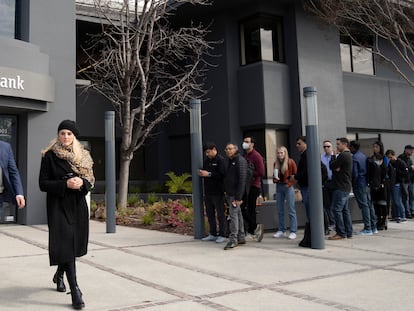Gita Gopinath: ‘Central banks in Latin America need to stay the course’
The deputy managing director of the International Monetary Fund talks to EL PAÍS about how high inflation is limiting economic growth, government spending and the organization’s new agreement with Argentina

This week, central bankers, finance ministers, lawyers, activists and academics are coming together in Washington in an event organized jointly by the International Monetary Fund (IMF) and the World Bank, known as the Spring Meetings. The goal of the event is to find solutions to the biggest economic problems facing the world. The list has been growing since the Covid-19 pandemic brought the world to a halt and claimed the lives of more than six million people. A year ago, the Russian war against Ukraine was added to the list, and this year, countries also have to worry about financial stability.
However, for Latin America, the most pressing problem seems to be inflation. The IMF estimates that consumer prices will average 13.3% this year, much higher than the 3.4% estimated for Asia. Unlike rich countries that could benefit from controlling spending, Latin American governments should prioritize targeted social assistance and investments in critical infrastructure, says Gita Gopinath, deputy managing director of the IMF in an interview with EL PAÍS. “It is also important to start raising your revenues,” says the 51-year-old economist over a conference call from her office. “All of those pieces are needed.”
Question. The theme of the IMF outlook report is “A rocky recovery.” As we move beyond the post-Covid economic rebounds in Latin America, why are we still talking about a recovery?
Answer. That’s a great question, actually. There have been multiple shocks, there was the pandemic, then came the war in Ukraine, and that affected economies in different ways, some to a larger extent than others. So, yes, there was a rebound after the pandemic in many countries: we saw it especially in the rise of consumption spending and services. Last year was very strong for Latin America, with 4% growth, because of this recovery from the pandemic. But we still see that countries need additional recovery, especially if you look at where they would have been in the absence of the pandemic and the war. In many countries, there is still a gap between where we’re projecting output to be and where it would have been in the absence of the pandemic and the war. So in that sense, there is still convergence happening.
That said, often shocks of this kind can lead to permanent deviations, where you never actually get back to the pre-pandemic, pre-war path. For several emerging and developing countries, that is the case now. It is country specific. Some are very close to where they were before, others are not. The rocky path of the recovery captures the fact that we have an inflation problem while trying to have a full recovery, and when you have high inflation, you need to have tight monetary policy. Fiscal policy also needs to be consistent with bringing inflation down in that environment. You can have high financial stability risks, especially when we’re coming out of a period of very low interest rates that have led to different vulnerabilities in the system. At this moment, markets are calm and spillovers to Latin America from the episode of SVB or Credit Suisse have been minimal. But I don’t think we can be complacent, and we can’t ignore the fact that there are significant downside risks that we need to keep our mind on.
Q. We’ve seen tensions start to rise between governments and central banks over tightening monetary policy. What do you think of the efforts of central banks in Latin America, and how do you see monetary policy moving forward?
A. It’s laudable that countries in the region moved quickly to address rising inflation. In a sense, they were ahead of the curve, doing what was needed to bring inflation down, so interest rates went up significantly. Now we’re seeing inflation come down from its peaks and moderate. It’s also being helped by energy prices coming down around the world. That said, we still have levels of inflation that are far above the central bank targets and we cannot assume that inflation will now just definitively return back to target. This is the time to remain vigilant and data driven and to keep monetary policy tight, to make sure that we bring inflation down durably. We know that there are lags with which monetary policy operates. It can take time. The extent of that lag varies across countries, but we think that we could be now in a phase where the effects of monetary policy are beginning to show up more tangibly in the data. We’re seeing this in high frequency indicators and in tightening demand. But it’s still too early to take your eye off inflation. They need to stay the course.
Q. Argentina recently signed a new agreement with the IMF in which the foreign reserve targets were lowered. Do you think that will be enough for Argentina to meet them? Or might there be another reduction, perhaps in the fiscal deficit targets?
A. We just completed the fourth review of the program for Argentina on March 31, and we dispersed around $5.4 billion. If I just step back and look at the changes over time, I would say that in the second half of the year, because of prudent macro management, we started seeing inflation coming down. But then at the start of the year, the country is hit by a severe drought. This is a fundamental change, a big shock to the system. At the same time, there have been policy setbacks. The most recent review that we did recognized that, because of the drought, there would need to be some offset in terms of the reserve target because this is a very sizable shock to the economy.
But, keeping in mind that the economic situation is highly fragile in Argentina, the program needs to serve as an anchor to be able to bring inflation down, even if it is at a slow pace. To make sure it is going in the right direction, to make sure that the parallel market exchange rate is not so far off from the official rate — all of that requires confidence that there will be sufficient reserves and that fiscal policy will remain consistent with bringing inflation down, which requires strong measures on the spending side to contain fiscal spending. It also requires that spending is well targeted. The announcements that, for instance, energy subsidies are targeted to the most vulnerable is critical. Much more targeted social assistance is needed. It’s a very difficult juncture. There is a shared understanding with the authorities that even stronger efforts are required to be able to have a good macro environment. To be able to have consistent fiscal policy, monetary policy and foreign exchange policy that can then deliver on bringing inflation down and avoiding huge disruptions in the domestic bond market. We will continue to work closely with the authorities and see what is needed in terms of stronger policies to be able to head towards greater macro stability.
Q. Considering the social unrest we’ve seen in Latin America over inequality and poverty, as well as the fact that borrowing costs are high, what should governments be spending on?
A. For Latin America, given the strength of inflation and the fact that labor markets are tight in many of the countries, there is a need to bring inflation down. Yes, monetary policy has a very important role in doing that, but fiscal policy also needs to contribute. Our recommendation is to have some level of fiscal consolidation for two reasons. One, to help bring inflation down and two, to rebuild buffers, given that we are in a highly shock prone world.
It is still very possible for countries to ensure that they’re helping the most vulnerable while doing both these things. We are in favor of targeted cash transfers, for example. We are not so in favor of broad based subsidies that then tend to be, in fact, regressive. For instance, if you give energy subsidies to everybody in the economy, we do not think this is good policy. We think it’s absolutely critical to maintain spending on health care, on education and invest in critical public infrastructure. These are the kinds of things you want to protect, while making sure that you have much more targeted social assistance. And lastly, it is also important to start raising your revenues. This involves improving the efficiency of the tax system and, in several cases, also improving the effectiveness of the progressivity of the tax system. All of those pieces are needed.
Sign up for our weekly newsletter to get more English-language news coverage from EL PAÍS USA Edition
Tu suscripción se está usando en otro dispositivo
¿Quieres añadir otro usuario a tu suscripción?
Si continúas leyendo en este dispositivo, no se podrá leer en el otro.
FlechaTu suscripción se está usando en otro dispositivo y solo puedes acceder a EL PAÍS desde un dispositivo a la vez.
Si quieres compartir tu cuenta, cambia tu suscripción a la modalidad Premium, así podrás añadir otro usuario. Cada uno accederá con su propia cuenta de email, lo que os permitirá personalizar vuestra experiencia en EL PAÍS.
¿Tienes una suscripción de empresa? Accede aquí para contratar más cuentas.
En el caso de no saber quién está usando tu cuenta, te recomendamos cambiar tu contraseña aquí.
Si decides continuar compartiendo tu cuenta, este mensaje se mostrará en tu dispositivo y en el de la otra persona que está usando tu cuenta de forma indefinida, afectando a tu experiencia de lectura. Puedes consultar aquí los términos y condiciones de la suscripción digital.
More information
Últimas noticias
Most viewed
- Sinaloa Cartel war is taking its toll on Los Chapitos
- Oona Chaplin: ‘I told James Cameron that I was living in a treehouse and starting a permaculture project with a friend’
- Reinhard Genzel, Nobel laureate in physics: ‘One-minute videos will never give you the truth’
- Why the price of coffee has skyrocketed: from Brazilian plantations to specialty coffee houses
- Silver prices are going crazy: This is what’s fueling the rally











































